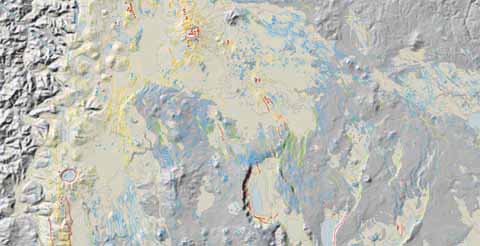

U.S. Department of the Interior
Gale A. Norton
U.S. Geological Survey
Charles G. Groat, Director
This report is preliminary and has not been reviewed for conformity with U.S. Geological Survey (USGS) editorial standards or with the North American Stratigraphic Code. Any use of trade, firm, or product names is for descriptive purposes only and does not imply endorsement by the U.S. Government.
1
Department of Geological Sciences, University of Oregon, Eugene, OR 97403
2
U.S. Geological Survey, M.S. 977, 345 Middlefield Road, Menlo Park, 94025
This is the online version of a CD-ROM publication. We have updated the eastern portion of our previous active fault map of Oregon (Pezzopane, Nakata, and Weldon, 1992) as a contribution to the larger USGS effort to produce digital maps of active faults in the Pacific Northwest region. The 1992 fault map has seen wide distribution and has been reproduced in essentially all subsequent compilations of active faults of Oregon. The new map provides a substantial update of known active or suspected active faults east of the Cascades. Improvements in the new map include (1) many newly recognized active faults, (2) a linked ArcInfo map and reference database, (3) more precise locations for previously recognized faults on shaded relief quadrangles generated from USGS 30-m digital elevations models (DEM), (4) more uniform coverage resulting in more consistent grouping of the ages of active faults, and (5) a new category of "possibly" active faults that share characteristics with known active faults, but have not been studied adequately to assess their activity. The distribution of active faults has not changed substantially from the original Pezzopane, Nakata and Weldon map. Most faults occur in the south-central Basin and Range tectonic province that is located in the backarc portion of the Cascadia subduction margin. These faults occur in zones consisting of numerous short faults with similar rates, ages, and styles of movement. Many active faults strongly correlate with the most active volcanic centers of Oregon, including Newberry Craters and Crater Lake.

This report includes Portable Document Format (PDF) files for which you will need Adobe Acrobat or other software that can read PDFs. You can download a copy of the latest version of Acrobat (6.0 at the time of this publication) by clicking the button above.
1_README.TXT Overview of the orqfault project
attributes.txt Fault attributes in Microsoft tab-separated-ASCII format
attributes.xls Fault attributes in Microsoft Excel format
files.txt List of files for the CD-ROM version of this publication
notes-references.txt Fault notes and references in tab-separated-ASCII format
notes-references.xls Fault notes and references in Microsoft Excel format
orqfaults.apr ArcView project file. The ArcView project orqfaults.apr can be run on a computer that has ArcView installed. The project can be copied to a hard drive but since the project relies on the files in the faults and hillshade directories, they must also be copied and must remain in the same relative location to the ArcView project
orqfaults.txt Note about copying ArcView project files onto your hard disc (basically the note above)
Suggested citation and version history
faults/e00_files
orqfaults_dd.e00 - Arc/Info interchange format for faults in geographic coordinates
orqfaults_lam.e00 - Arc/Info interchange format for faults in lambert projection
faults/info .dir, .dat, and .nit files for Arc/Info coverages
faults/orqfaults_dd Arc/Info coverage of faults geographic coordinate system
faults/orqfaults_lam Arc/Info coverage of faults in lambert projection
hillshade -- Hillshade images; One degree hillshade images, yy = latitude and xxx = longitude. Provided as .tif, .aux, and .tfw files.
pdf/1to500000.pdf Hillshade image with faults.
pdf/1to500000ventgeol2.pdf Hillshade image with faults, vents, and Quaternary geology
pdf
yyxxx.pdf: One-degree hillshade images with faults, yy = latitude and xxx = longitude
For questions about the content of this report, contact Pat McCrory
Download a free copy of the current version of Acrobat Reader.
| Help
| PDF help
| Publications main page | Open-File
Reports for 2003 |
|
Privacy Statement | Disclaimer
| Accessibility |
|
Geologic Division | Western Mineral Resources |
A CD-ROM version of this publication is also available from:
U.S. Geological Survey, Information Services
Box 25286, Federal Center
Denver, CO 80225
Telephone: 1–888–ASK–USGS (1–888–275–8747)
E-mail: infoservices@usgs.gov